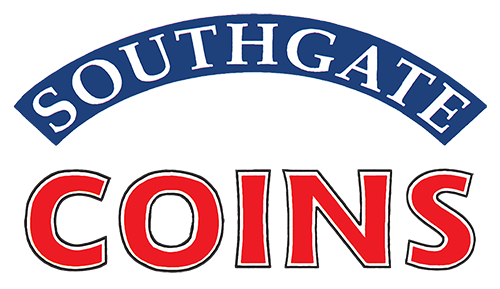A little inside look to what actually goes on at Southgate Coins. Somer tells the world of her experiences as a coin shop employee.
"Coin Shop? What Do You Do There?"
By Somer Athari
I get asked all the time, "What do you do at a coin shop?" I have to admit that it is a difficult question to answer to people who don't know much about the numismatic field. So this month's article will be devoted to what (we) the employees do at Southgate Coins.
I might as well start at the beginning. I show up 20 minutes before we open and I prepare the front display room for the day. I open up the store at 10:00 A.M., on the dot and make sure that everything is as it should be. All showcases must be presentable: no fingerprints, and every row is full of coins just aching to be sold. The boss' phrase is "We can't sell out of an empty wagon." Then I look to see if we are running low on any back-up coins[1]. If so, then I make a work-order informing the bosses that more of a particular coin needs to be processed[2]. All the while, if a customer is in the store and/or on the phone, then all of my energy is devoted to the customer and his/her needs.
"Here at Southgate Coins we feel that the customer is always the top priority," so I drop anything I am doing to aid the customer in any way that I can. Whether the question is about a 1943 "silver" penny (actually steel coated with zinc)[3] or a certain 1873-CC No Arrows dime, I am here with the answer. Here is where my social skills are put to the test, and my last article about good customer relations comes into effect. When customers are not in the store then I am busy with my side-work.
I check to see where all of our shipments are currently around the nation and the world. I also check to see if anyone has ordered the book we just recently published, which I am sure, you (the person reading this article) have already seen and ordered, I hope. We have been told that the Professional Numismatists Guild is considering nominating it for "Book of the Year," so I would order it if you haven't already. The Mint on Carson Street is a great book, and even if you aren't the biggest coin collector, you can still enjoy it for the history it provides on the Carson City Mint. (I just had to get that plug in. I like the book that much.) Anyways, back to my workload.
If there is no customer activity, whether in the store or on the phone, then there are the daily routines that are a constant part of our job description. We ship boxes, check CCE prices[4], update Greysheet prices, clean the store (constantly), flip coins[5], organize, perform various bookkeeping projects, and become more knowledgeable in this field that we (the few and proud) have been chosen to work in.
Now there are also special projects that each of us have been given to save time. Taking pictures of coins to put on the Web site (which I am sure you have already noticed in addition to this article), buying and selling on eBay, and of course my special project is this very article that you are reading. We are always challenged with something new to do, which makes the days that I work at Southgate Coins full of knowledgeable experiences that I cherish. The numismatic field has opened my mind to a euphoria of possibilities, which I wouldn't trade for the entire world…but maybe a St. Gauden's twenty dollar gold piece would fill the void.
**********
1. Back-up coins- the term back-up refers to any coins that we have outside of the cases but still marked/priced in the event where a coin is sold, leaving an empty space. This happens often so we keep these back-up boxes full of most of the coins we have in the showcases.
2, Processed- the term for when raw coins are flipped in the 2x2 cardboard holders and then marked and priced.
3. 1943 steel penny - In 1943, a critical year of the war, copper was in shortage. So, for that year, the treasury composed pennies with steel in order to provide more copper for bullets and other military needs.
4. CCE prices- CCE is an acronym for Certified Coin Exchange, which is a dealer-to-dealer network.
5. Flipping - this is a coin term that we use to describe the process of taking a raw coin and putting it into a 2x2 cardboard holder. You do this by placing the coin on one side of the cardboard, in a little plastic window that is on both sides of the rectangular cardboard piece. From there you fold the cardboard over the coin and staple three corners to hold the coin in place. Then in one of the corners, we identify the year and mintmark of the coin.
